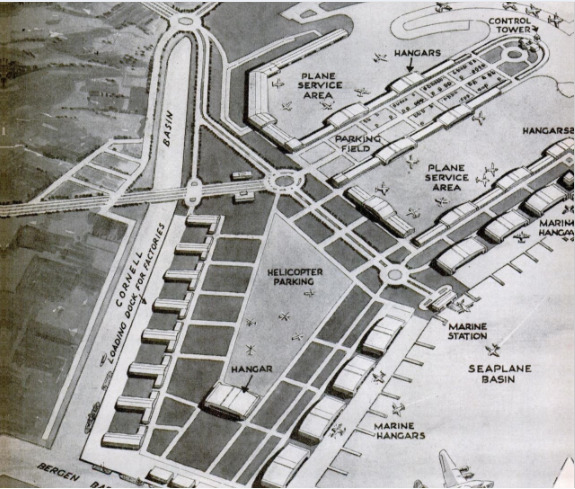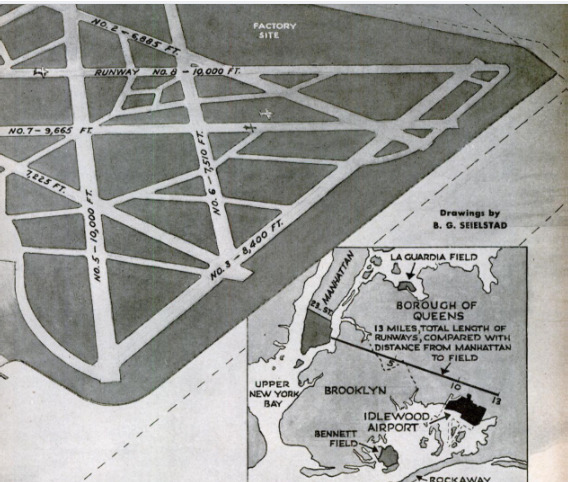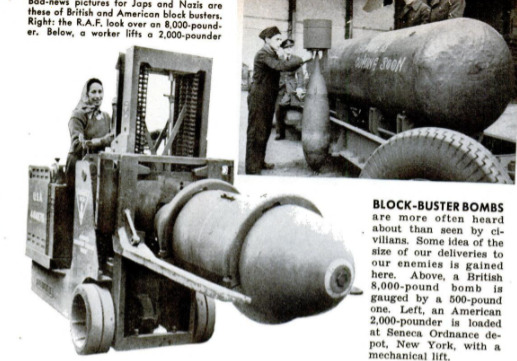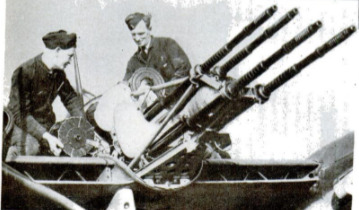-
Title (Dublin Core)
-
New York City's mega-airport
-
Article Title and/or Image Caption (Dublin Core)
-
World's greatest airport to serve the skyways of tomorrow
-
extracted text (Extract Text)
-
AGIANT skyways depot containing the
whole pattern of future air transpor-
tation is taking shape on our eastern sea-
board. It's destined to be the world's big-
gest and most modern airport—a formid-
able adjunct to America’s bid for postwar
aviation supremacy. Yet so quietly is it
progressing that few know of its where-
abouts, let alone its size or significance.
This is the second aerial wonder project
of New York's Mayor F. H. La Guardia and
his city planners. Just 10 miles to the north,
across the Borough of Queens, the first
great municipal field bearing his name
handles more traffic than any other city air-
port in the land. It was regarded as mam-
moth when opened three years ago; but the
new airport, with its 2,576 acres, has five
times the area, and its design for traffic
may turn up the clock a decade.
Some of the Mayor's predictions:
“Scheduled flights that begin or end at the
new terminal will reach the staggering total
of 950 daily. They will include landings and
take-offs by super cargo and passenger
planes weighing up to 150 tons.
“Every hour on the hour a big airliner will
hop off for a trip across the Atlantic.
“Week-end jaunts to London and Paris
will be as easy, if not as common, as visits
from New York to Atlantic City are now.
“Children in New York will get fresh tree-
ripened bananas and other tropical fruits,
so vital to health, at one third the present
price each day by air from the West Indies
or Central America.”
When the new airport, with its 13 miles
of concrete runways for land planes and
three huge landing areas in Jamaica Bay
for seaplanes, begins operation, it will re-
lieve La Guardia Field of international and
transcontinental traffic. But the Mayor pre-
dicts both will be kept busy. La Guardia
Field will get flight schedules for all short
hauls on the East Coast, and those west to
Chicago and north to Montreal.
Atop 10 feet of hard-packed sand that
covers the field, workers will pour enough
concrete for runways to build a highway
20 feet wide from New York to Washington.
Never have there been such giant strips.
The runways, each 200 feet wide, will be
laid in pairs in four wind directions. Planes
will be able to land and take off simultane-
ously on each pair of runways. The three
largest runways will be two miles long, the
longest in the world. Concrete will be 12
inches thick on all runways and on the five
miles of taxiways, 100 feet wide, connect
ing the runways. The seaplane landing
areas will be two miles long and 1,000 to
1,500 feet wide.
Everything is being done to make this
airport’ the greatest. The designer, Jay
Downer, his engineering and architectural
associates, and John McKenzie, New York's
Commissioner of Marine and Aviation, have
tapped the nation's pool of aviation knowl
edge. Every plan and blueprint 100ks to the
demands of the future.
Structures necessary to handle the con-
templated traffic at the airport stagger the
imagination. There must be, in addition to
the glant control tower and ticket offices
of aviation companies, buildings for United
States customs and immigration authori-
ties, communications, storage warehouses,
hangars, restaurants and cafeterias, and
concessions. Ten thousand people are ex-
pected to commute there daily from the
city and suburbs,
Passenger and freight schedules will be
arranged to eliminate conflict. The bulk of
the passenger traffic probably will be routed
mornings, afternoons, and early evenings,
with freight haulage moving late at night.
Other innovations: Portable control tow-
ers are planned as auxiliaries to the main
control tower to overcome limited vision
caused by the huge size of the field; “nose
hangars” may be built instead of conven-
tional hangars to protect planes, thus sav-
ing millions of dollars in material; fog-
busting radio mechanisms may make it
possible for planes to land and take off in
bad weather; a system is planned in which
passengers may be saved all walking to and
from planes by a new-type “chariot” with
built-in gangway; landing space is provided
in parking areas for helicopters to shuttle
in with passengers from the very heart of
Manhattan, from La Guardia Field, and from
other points.—JACK O’BRINE.
-
Language (Dublin Core)
-
eng
-
Date Issued (Dublin Core)
-
1943-08
-
pages (Bibliographic Ontology)
-
74-80
-
Rights (Dublin Core)
-
Public Domain (Google Digitized)
-
Archived by (Dublin Core)
-
Matteo Ridolfi
-
Marco Bortolami (editor)
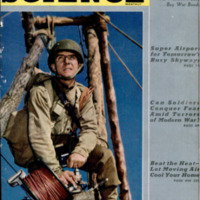 Popular Science Monthly, v. 143, n. 2, 1943
Popular Science Monthly, v. 143, n. 2, 1943

